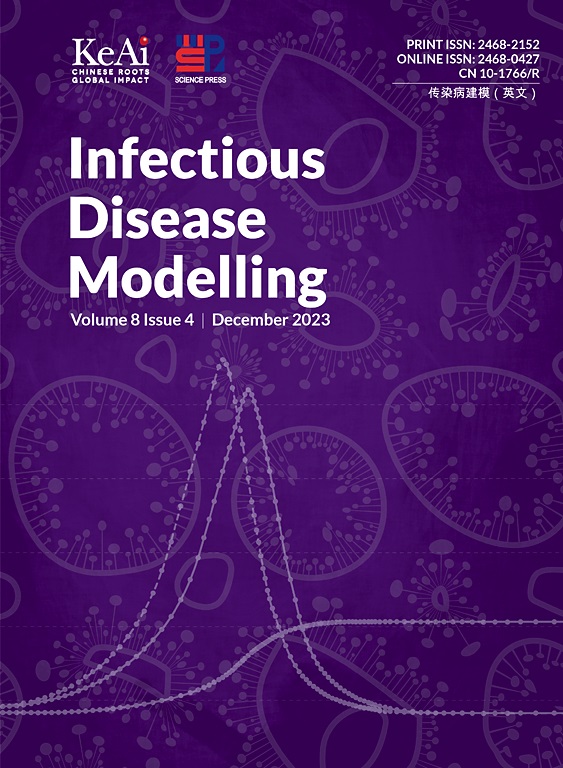Hybrid metapopulation agent-based epidemiological models for efficient insight on the individual scale: A contribution to green computing
IF 2.5
3区 医学
Q1 Medicine
引用次数: 0
Abstract
Emerging infectious diseases and climate change are two of the major challenges in 21st century. Although over the past decades, highly-resolved mathematical models have contributed in understanding dynamics of infectious diseases and are of great aid when it comes to finding suitable intervention measures, they may need substantial computational effort and produce significant CO2 emissions. Two popular modeling approaches for mitigating infectious disease dynamics are agent-based and population-based models. Agent-based models (ABMs) offer a microscopic view and are thus able to capture heterogeneous human contact behavior and mobility patterns. However, insights on individual-level dynamics come with high computational effort that scales with the number of agents. On the other hand, population-based models (PBMs) using e.g. ordinary differential equations (ODEs) are computationally efficient even for large populations due to their complexity being independent of the population size. Yet, population-based models are restricted in their granularity as they assume a (to some extent) homogeneous and well-mixed population. To manage the trade-off between computational complexity and level of detail, we propose spatial- and temporal-hybrid models that use ABMs only in an area or time frame of interest. To account for relevant influences to disease dynamics, e.g., from outside, due to commuting activities, we use population-based models, only adding moderate computational costs. Our hybridization approach demonstrates significant reduction in computational effort by up to 98% – without losing the required depth in information in the focus frame. The hybrid models used in our numerical simulations are based on two recently proposed models, however, any suitable combination of ABM and PBM could be used, too. Concluding, hybrid epidemiological models can provide insights on the individual scale where necessary, using aggregated models where possible, thereby making a contribution to green computing.
基于混合元种群主体的流行病学模型在个体尺度上的有效洞察:对绿色计算的贡献
新发传染病和气候变化是21世纪面临的两大挑战。虽然在过去的几十年里,高分辨率的数学模型在理解传染病的动力学方面做出了贡献,并且在寻找合适的干预措施方面有很大的帮助,但它们可能需要大量的计算工作并产生大量的二氧化碳排放。缓解传染病动力学的两种流行建模方法是基于主体的模型和基于群体的模型。基于主体的模型(ABMs)提供了微观视角,因此能够捕捉异质的人类接触行为和移动模式。然而,对个人层面动态的见解需要大量的计算工作,并且随着代理数量的增加而增加。另一方面,使用常微分方程(ode)等基于种群的模型(PBMs)即使对于大种群也是计算效率高的,因为它们的复杂性与种群规模无关。然而,基于人口的模型在粒度上受到限制,因为它们假设(在某种程度上)同质且混合良好的人口。为了管理计算复杂性和细节水平之间的权衡,我们提出了空间和时间混合模型,该模型仅在感兴趣的区域或时间框架中使用ABMs。为了考虑疾病动态的相关影响,例如,来自外部,由于通勤活动,我们使用基于人口的模型,仅增加适度的计算成本。我们的杂交方法表明,计算工作量显著减少高达98%,而不会失去焦点框架中所需的信息深度。数值模拟中使用的混合模型是基于最近提出的两种模型,但也可以使用任何合适的ABM和PBM组合。总之,混合流行病学模型可以在必要时提供个人规模的见解,在可能的情况下使用聚合模型,从而为绿色计算做出贡献。
本文章由计算机程序翻译,如有差异,请以英文原文为准。
求助全文
约1分钟内获得全文
求助全文
来源期刊

Infectious Disease Modelling
Mathematics-Applied Mathematics
CiteScore
17.00
自引率
3.40%
发文量
73
审稿时长
17 weeks
期刊介绍:
Infectious Disease Modelling is an open access journal that undergoes peer-review. Its main objective is to facilitate research that combines mathematical modelling, retrieval and analysis of infection disease data, and public health decision support. The journal actively encourages original research that improves this interface, as well as review articles that highlight innovative methodologies relevant to data collection, informatics, and policy making in the field of public health.
 求助内容:
求助内容: 应助结果提醒方式:
应助结果提醒方式:


